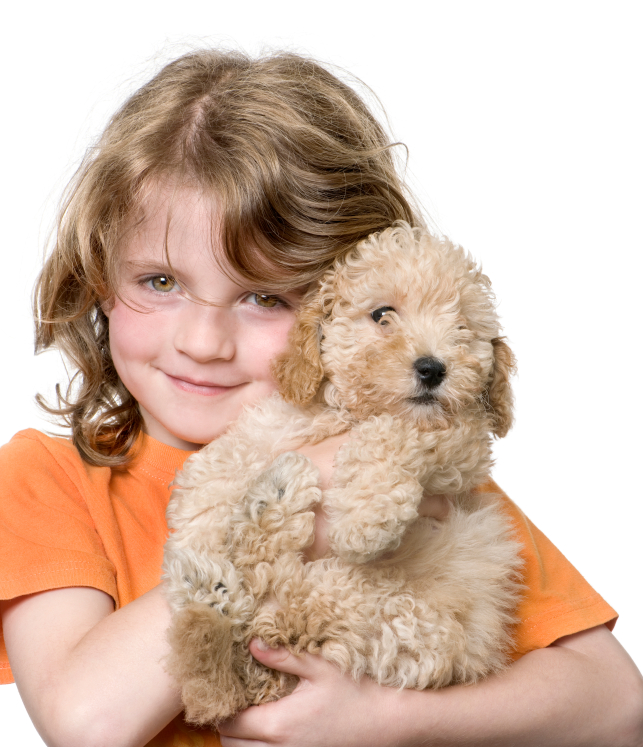How to Introduce Dogs and Children
Many of us have a fairytale image of a child and his dog, best friends forever. Think of Lassie and Timmy, Dorothy and Toto, or Snoopy and Charlie Brown. You probably have  fond memories of your own beloved childhood pet. But are children and dogs a perfect match? It depends.
fond memories of your own beloved childhood pet. But are children and dogs a perfect match? It depends.
As of 2010, over 45% of households in the United States owned at least one dog, making canines the most popular family pet in the country.1 Children are naturally drawn to dogs, and many dogs seem to genuinely enjoy interacting with kids. Raising children with pets provides many benefits. According to the American Academy of Child & Adolescent Psychiatry, pets can:
- Teach empathy and compassion
- Provide love, loyalty and affection
- Foster self esteem
- Promote physical activity
- Teach responsibility
- Provide valuable life lessons
- Provide a connection to nature.2
Children who live with pets learn positive lessons that last a lifetime. What dog lover wouldn’t want this for their child?
But according to the CDC, about 800,000 Americans per year are treated for dog bites, and more than half of the victims are children.3 Children are much more likely than adults to be bitten in the face, head and neck. Dog aggression can have severe consequences for children, both physical and psychological. A child can learn to fear dogs for life. Proper awareness and education are needed to prevent this.

The truth about kids and dogs
Children can be very threatening to dogs. A small child is literally “in a dog’s face” because of their small stature. Children make abrupt movements and startling high-pitched noises that are very unnerving to a dog. Very young children may regard a pet as an animated stuffed toy just begging to be squeezed, poked and chased. Babies and toddlers can’t control their own aggressive impulses, nor do they have the cognitive skills to empathize with another creature’s fear or discomfort. By school-age, children learn empathy, but they still may have trouble interpreting an animal’s body language. They may not recognize that a dog’s growl or stiffened posture means “back off!”
Dogs are programmed to relate to us in certain ways. They are pack animals with a hierarchical social system. A dog tends to view adult humans as “alpha.” But with kids it’s not always so clear. Children might be regarded as equals or even subordinates. A pushy dog might posture, snarl, and then eventually snap at a child to keep them in line. A dog is just communicating displeasure in the way he knows best. This is probably how many bite injuries happen.
Some dogs, for their part, just don’t love kids. They may have had little or no exposure to children—or worse, a bad history with them. A dog who has been taunted or teased by a child in the past may be unable to trust again.
The bottom line is that kids will be kids and dogs will be dogs. Here’s how to bring out the best in both.
Dog-proof your child
- The number one precaution for kids and dogs is to supervise at all times. Author and trainer Brian Kilcommons sums it up best when he says that “leaving a dog alone with a child is like leaving two toddlers in the same room, one with a pair of scissors.4” Sooner or later something can and will go wrong.
- Don’t fall prey to the old-school mantra that “a child can do anything to my dog and she’ll never react.” Even the best dog in the world could lash out if hurt or startled. Besides, it’s a poor excuse for not teaching a child the proper way to behave.
- Teach your child how to interact with a dog. Show her how to first offer her closed fist for the dog to sniff, then gently stroke the head and neck, avoiding more sensitive areas such as ears, tail, feet and belly. Stroke your toddler’s arm gently to show how good it feels. Explain that poking, squeezing or pulling at the dog isn’t OK. Quiet voices are a must as well.
- Teach your child never to put her face near a dog’s face. The risk is too great.
- Never touch the dog when she is eating, chewing or sleeping. "Let sleeping dogs lie” is the safest plan.
- Do not allow rough play. This only encourages aggression. Teach your child appropriate ways to play with your dog using safe toys. Teach the difference between teasing and playing.
- Model the proper behavior by treating your dog with and respect at all times. Never yell at your dog or use physical punishment.
- Teach your children that they must always ask permission before interacting with someone else’s dog. Children should ignore dogs who are confined behind fences, left in a vehicle, crated, or tethered to a tree. Confinement can make dogs more territorial and reactive.
- Involve older children in caring for your dog. Seven- to eight-year-olds can replenish food and water bowls; ten year olds can help with grooming, practice basic commands, or engage in a game of fetch. Depending on the dog’s size and leash manners, an older child can take the dog out for short walks. This is a great way for children to start learning responsibility for other living things.
Child-proof your dog
- A secure dog knows his place in the family pecking order. Remind your dog who’s alpha. Step up the obedience training. Work on basic commands such as SIT, STAY and OFF. Teach your old dog new tricks!
- Put your dog in a SIT, STAY or DOWN before allowing your child to approach. This reminds your dog that she is subordinate, and there’s no need to test the status quo. And remember, always supervise!
- If a new baby is on the way, help your dog adjust. Gradually introduce new baby furniture, bedding, and equipment before the baby arrives. While your newborn is still in the hospital, consider bringing home a nursery blanket or onesie with the baby’s scent. This will lessen the shock when the baby finally comes home.
- Expose your puppy or younger dog to all different experiences and types and ages of people. Dogs who have positive experiences with children at a young age are more likely to be kid-friendly as adults.
- Bring your dog for regular veterinary checkups and fecal examinations. Your veterinarian will make sure your dog is appropriately vaccinated and free of infections and parasites that could pose a risk to your family. Your vet can diagnose and treat painful conditions such as dental disease, ear infections, and arthritis that could make your dog irritable.
- If your dog shows repeated aggressive tendencies towards kids, seek professional veterinary advice immediately. Left untreated, these problems will only intensify with time.
Choosing a family dog
When choosing a purebred dog to go with children, opt for breeds with laid-back, friendly temperaments. High-energy dogs with a strong herding drive or protective instinct may not be the best choice for a family with children, although for every rule there is an exception. It is wise to choose a dog that is large and sturdy enough not to be easily injured by a child, but perhaps not so large as to knock a small child over.
Consider whether you have the time and effort to put towards caring for a young puppy. Adult dogs not only require less work, but their temperaments are easier to determine. There are many wonderful shelter dogs looking for a good home. Canine rescue organizations— whether general or breed-specific—go out of their way to screen dogs and families for the appropriate fit. They can be a wonderful resource for pets with a kid-friendly track record. Your veterinarian can also advise what dog would best suit your family.
Update on Pet Allergies
Experts used to think that exposure to furry pets promoted allergies and asthma in young children. Sadly, expectant parents with a family history of allergies might be told to get rid of the family cat or dog. Newer research indicates that the exact opposite is true. One prominent 2002 study indicated that having two or more dogs and cats during the first year of life actually reduced the child’s chance of having pet allergies at ages six and seven.5 It seems that early exposure to pets can actually “educate” the immune system in children.
Learning empathy and respect for another living creature is the best education of all.
- “Industry Specifics and Trends” 2011. American Pet Products Association. 26 February 2011 http://www.americanpetproducts.org/press_industrytrends.asp
- “Facts for Families #75: Pets and Children” 2006. American Association of Child & Adolescent Psychiatry. 26 February 2011 http://aacap.org/page.ww?name=Pets+and+Children§ion=Facts+for+Families
- “Dog Bite: Fact Sheet” 2008. Centers for Disease Control and Prevention. 26 February 2011 http://www.cdc.gov/HomeandRecreationalSafety/Dog-Bites/dogbite-factsheet.html
- Kilcommons, B. Good Owners, Great Dogs. New York: Time Warner, 1992.
- Ownby D. “Exposure to Dogs and Cats in the First Year of Life and Risk of Allergic Sensitization at 6 to 7 Years of Age. Journal of the American Medical Association, 288(8) (2002): 963-72.
You May Also Like These Articles:
How to Stop Your Dog from Jumping on People
Why Do Dogs Chase Their Tails?
Dog Adoption: What You Need to Know
Clicker Training for Dogs: An Overview
Disclaimer: This website is not intended to replace professional consultation, diagnosis, or treatment by a licensed veterinarian. If you require any veterinary related advice, contact your veterinarian promptly. Information at DogHealth.com is exclusively of a general reference nature. Do not disregard veterinary advice or delay treatment as a result of accessing information at this site. Just Answer is an external service not affiliated with DogHealth.com.
Notice: Ask-a-Vet is an affiliated service for those who wish to speak with a veterinary professional about their pet's specific condition. Initially, a bot will ask questions to determine the general nature of your concern. Then, you will be transferred to a human. There is a charge for the service if you choose to connect to a veterinarian. Ask-a-Vet is not manned by the staff or owners of DogHealth.com, and the advice given should not delay or replace a visit to your veterinarian.



